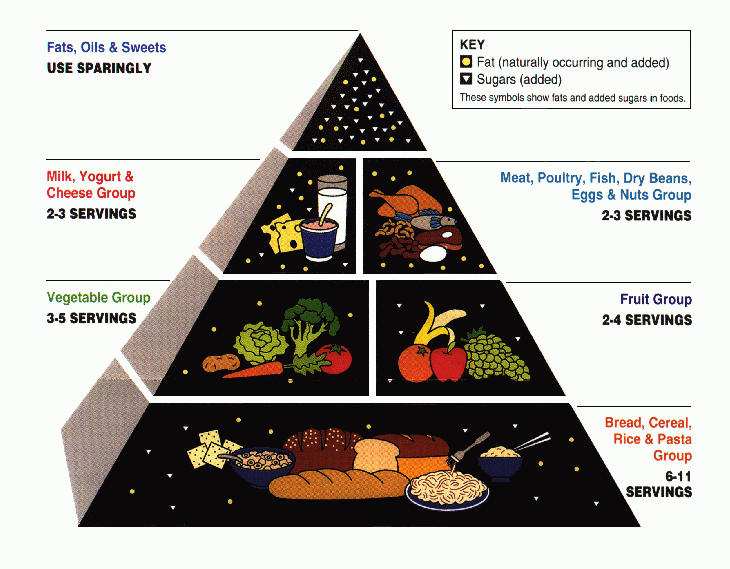What is a Food Pyramid?
Food pyramid is a graphical representation of healthy diet based on nutritional recommendations in the form of a pyramid. Shown below is an image of a food guide pyramid from USDA. All food groups are equally important and we cannot substitute one group for the other.

Grains are at the base of the food pyramid.
They are also a good source of fiber. You may choose from wheat, corn, oatmeal, rice, barley, brown rice. Recommended servings for grains are 6-11 per day. Whole grains are better because they have more fiber, vitamins and minerals than simple or processed grains. The fiber in whole grains also helps make you feel full and eat less.
Vegetables and fruits are the next tier in the food pyramid.
Vegetables provide fiber and are a good source of vitamins and minerals. Darker the color of the vegetable, more is the nutritional value. Try to eat a variety of fresh vegetables like carrots, cucumbers, tomatoes, broccoli, peas, spinach, lettuce etc. Recommended servings of vegetables are 3-5 per day.
Fruits are a rich source of iron, Vitamin A, Vitamin C, folate and potassium. They are low in fat and sodium and high in fiber. You may pick from apples, bananas, oranges, berries etc. You could go easy on fruit juices with added sugars and focus on whole fruits instead. Recommended servings for fruits is 2-4 per day.
The next tier is dairy products and proteins.
The dairy products are an important source of calcium and Vitamin D. These include milk, yogurt and cheese. Try to choose low fat and nonfat options. Recommended servings of dairy products are 2-3 per day.
The proteins group includes eggs, beans, lentils, peas, nuts, peanut butter, meat, poultry and fish. They are a rich source of proteins and iron. Avoid frying these foods. Recommended servings of proteins are 2-3 per day.
The top most tier in the food pyramid is fats, oils and sweets.
Fats and oils are an important source of essential fatty acids. Try to choose healthier fats such as olive oil, canola oil and the oil in nuts and fish. Consumption of solid fats and sweets including butter, cream, margarine, salad dressings, refined sugars, soft drinks, candies, and desserts should be limited. Fats are essential during the early growth and development. They should be gradually reduced post toddler years. Sparing use of oils, fats and refined sugars is recommended.
Vitamins and Minerals
Vitamins are nutrients that are needed for normal cell function, growth and development. They are needed only in small amounts. Although vitamins do not provide energy in the form of calories, they are important in energy producing reactions in the body.
Eating is all about choices. There are so many choices that it can be hard to know where to start. Try to eat a variety of foods and beverages from all of the food groups. Try to consume foods that are low in saturated fats, trans fats, cholesterol, added sugars and salt.
Use the “Food Pyramid” to help choose a balanced diet that has enough calories and nutrients from all food groups. To maintain a healthy body weight, we should balance the calories that we consume from foods and beverages with the calories that we use being active. Try to get plenty of physical activity and reduce sedentary activities.
This blog provides general information and discussions about health and nutrition. The information and other content provided in this blog, website or in any linked materials is not a substitute for professional medical expertise or treatment.
If you or any other person has a medical concern, you should consult with your health care provider or seek other professional medical treatment immediately. Never disregard professional medical advice or delay in seeking it because of something that you have read on this blog, website or in any linked materials.
References:
- myplate.gov
- https://www.dietaryguidelines.gov/
